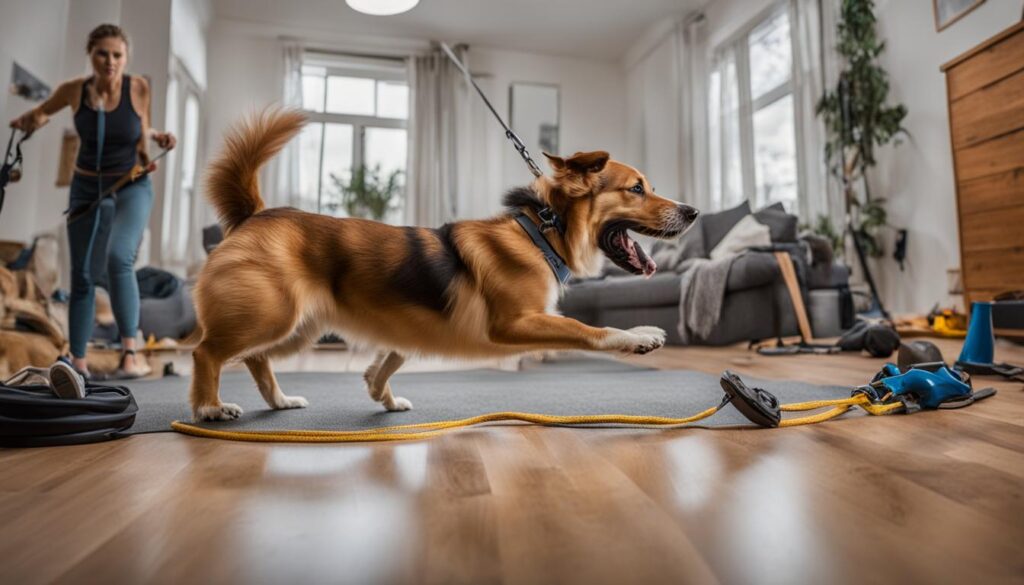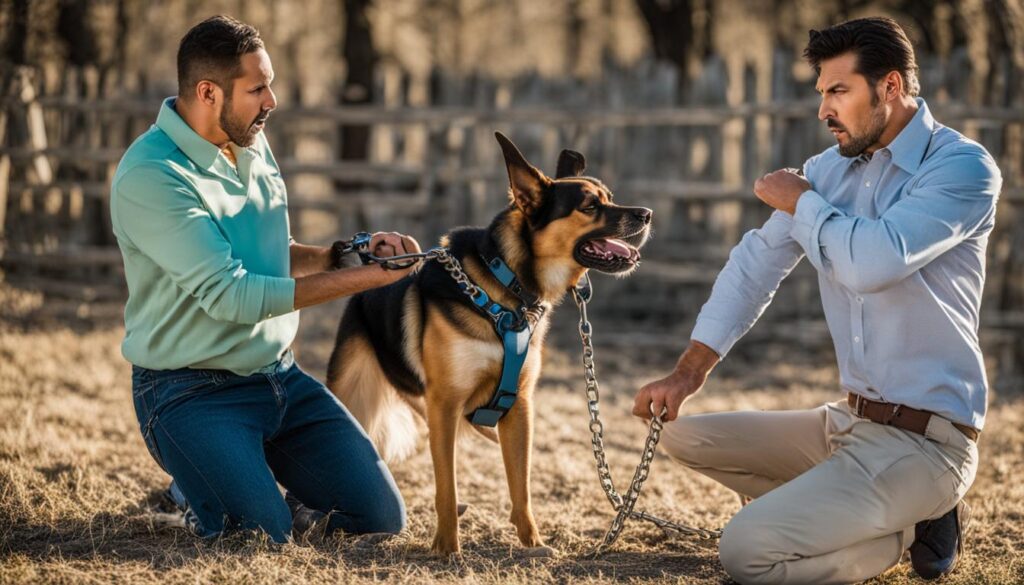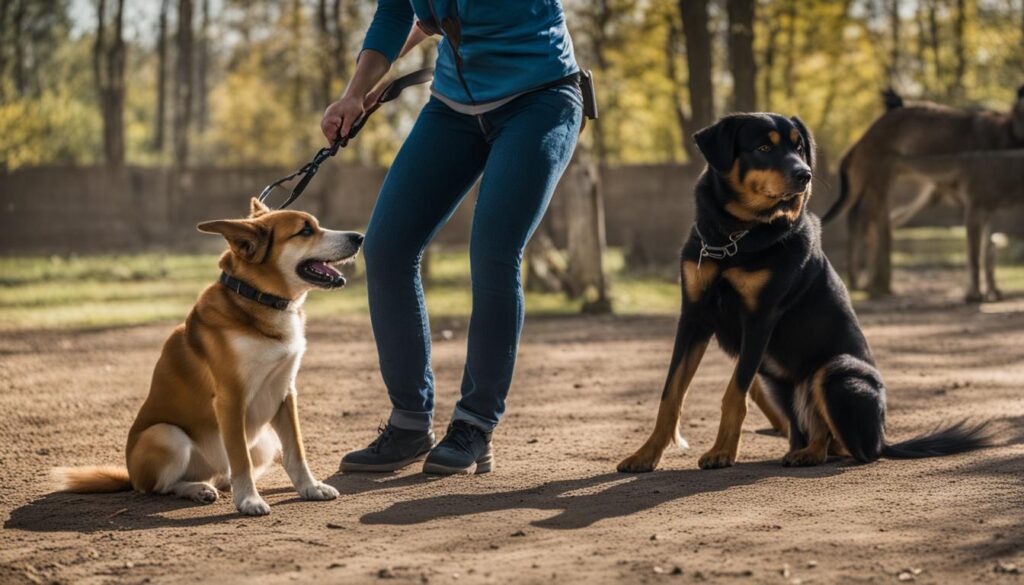When it comes to training your beloved dog, it’s crucial to be aware of the common mistakes that many dog owners make. These mistakes can hinder your dog’s progress and make the training process frustrating for both of you. By understanding and avoiding these errors, you can ensure successful training and a positive experience for you and your furry friend.
1. Cue Nagging and Poisoning of Cues
When it comes to dog training, cue nagging and poisoning of cues are blunders that many owners unknowingly make. Let’s take a closer look at what these mistakes entail and how to avoid them.
Cue nagging occurs when a dog doesn’t respond to a cue, and the owner keeps repeating it in hopes of getting a reaction. However, this practice can backfire. The dog learns to ignore the cue until it is repeated multiple times, leading to confusion and inconsistency in training. To prevent cue nagging, it’s crucial to say cues only once and avoid unnecessary repetition.
“Repeating cues excessively not only undermines the effectiveness of training but also strains the communication between you and your furry friend.”
On the other hand, poisoning of cues happens when a cue or behavior is associated with something negative. For example, if a dog associates the “sit” cue with scolding or punishment, they may stop responding altogether. This can cause frustration and hinder progress in training. To avoid poisoning cues, it’s vital to create positive associations with the cues and behaviors you want to reinforce.
“Building trust and positive emotions around cues helps foster a strong bond between you and your dog, enhancing the effectiveness of training.”
Remember, clear and consistent communication is key in dog training. By avoiding cue nagging and poisoning of cues, you can set your dog up for success and establish a harmonious training environment.
Benefits of Avoiding Cue Nagging and Poisoning of Cues
- Improved communication between you and your dog
- Enhanced focus and responsiveness during training sessions
- Faster progress in learning new behaviors and commands
- Strengthened bond and trust between you and your furry companion
2. Failing to Practice in-between Classes
One of the most common dog training errors is failing to practice consistently in-between classes. While attending training classes is important, the real progress happens when you continue the training at home.
Reinforcing the learned behaviors and ensuring progress requires regular practice. Dogs thrive on repetition and consistency, so it’s essential to dedicate time every day to work with your furry friend.
By practicing for short periods each day, you can maintain a well-behaved dog and reinforce the training they received in class. Consistency is key to solidifying the new commands and behaviors they’ve learned.
To help you stay on track, set a training schedule and commit to it. Make it a part of your daily routine, and set aside dedicated time to work on obedience, commands, and tricks with your dog.
| Benefits of Regular Practice | How to Incorporate Practice into Your Routine |
|---|---|
| – Reinforces learned behaviors | – Set a training schedule |
| – Ensures progress in training | – Dedicate daily time for training |
| – Builds a stronger bond with your dog | – Make it a part of your daily routine |
| – Improves overall obedience and listening skills | – Stay consistent and committed |
Remember, failing to practice in-between classes is one of the most ineffective dog training techniques. Consistent and regular training sessions will help you achieve the desired results and maintain a well-behaved dog.
3. Useless Repetition
One of the biggest dog training mistakes is falling into the trap of useless repetition. You may find yourself repeating the same method or command over and over again, expecting different results. However, this approach can actually hinder your dog’s training progress.
When a particular method or command is not working, it’s essential to evaluate your dog’s response and be willing to try a different approach. Every dog is unique, and what works for one may not work for another. Repetition without adaptation can lead to frustration and confusion for both you and your dog.
To avoid this mistake, it’s important to be observant and flexible in your training sessions. Pay attention to your dog’s reactions and body language. If you notice that a certain method or command is not eliciting the desired response, it’s time to switch things up and try something new.
Remember, effective dog training requires patience, consistency, and adaptability. Don’t be afraid to experiment with different techniques and approaches until you find what works best for your furry companion.
Pro Tip: Keep in mind that training should be a positive and enjoyable experience for both you and your dog. If you find yourself feeling frustrated or overwhelmed, take a break and come back to it when you’re feeling calmer and more focused.
Key Takeaways:
- Repeating the same method or command without adaptation is a common dog training mistake.
- Evaluate your dog’s response and be open to trying different approaches if a method is not working.
- Observe your dog’s reactions and body language during training sessions.
- Stay patient, consistent, and flexible in your training methods.

4. Working When You’re Frustrated
Training your dog requires patience and a calm mindset. It’s crucial to avoid training when you’re feeling frustrated or in a bad mood. Trying to train your dog when you’re not in the right mindset can lead to negative experiences and hinder the progress of your training sessions.
When you’re frustrated, it’s easy to become impatient and take out your frustration on your dog. This can result in negative interactions, such as raised voices or harsh handling, which can have long-lasting effects on your dog’s behavior and trust in you.
Instead of training when you’re frustrated, it’s best to engage in positive activities with your dog. Take a break and spend some time playing or snuggling together. This will not only help you relax but also strengthen the bond between you and your furry friend.
By avoiding training when you’re frustrated, you can create a positive and enjoyable training environment for both you and your dog. Remember, patience and a calm mindset are key to successful training sessions.
Benefits of Avoiding Training When Frustrated
Avoiding training when you’re frustrated brings several benefits:
- Positive interactions: By engaging in positive activities instead of training, you can foster a strong bond and positive relationship with your dog.
- Reduced stress: Taking a break from training when frustrated allows you to relax and reduce stress, creating a more enjoyable experience for both you and your dog.
- Improved focus: When you’re in the right mindset, you can better focus on your training goals and effectively communicate with your dog.
- Prevention of negative associations: By avoiding negative interactions during training, you can prevent your dog from associating training with frustration or fear, ensuring a positive learning experience.
Remember, Avoid These Training Errors
“Training your dog when you’re frustrated or in a bad mood is a common mistake many dog owners make. It’s important to recognize the impact of your emotions on your training sessions and choose positive interactions over negative ones.” – Dr. Emily Clarke, Canine Behavior Specialist
By being aware of the potential pitfalls and avoiding training when you’re frustrated, you can ensure that your dog training experiences are positive, effective, and enjoyable for both you and your furry companion.
| Mistake | Consequence | Solution |
|---|---|---|
| Training when frustrated | Negative interactions, hindered progress | Engage in positive activities, take a break, and train when calm and in a positive mindset |
| Impatient behavior | Damage to the dog-owner relationship, decreased trust | Practice patience and remain calm during training sessions |
| Increased stress for both dog and owner | Reduced enjoyment, potential for escalated negative behaviors | Take breaks, engage in activities that promote relaxation and bonding |
5. Using Shock, Prong, or Choke Collars
When it comes to dog training, it’s important to use effective and humane methods that prioritize your furry friend’s well-being. Unfortunately, some dog owners still turn to shock collars, prong collars, or choke collars as training tools. However, these methods are not only ineffective but can also have negative consequences for your dog’s behavior and emotional well-being.
Scientific research has shown that shock collars, which deliver electric shocks to the dog’s neck, can elicit fear, stress, and anxiety in dogs. This can lead to aggression or other unwanted behaviors as a result of the dog associating the training experience with pain or discomfort. Similarly, prong collars and choke collars, which apply pressure or pain to the dog’s neck, can cause physical harm and lead to fear or aggression.
In contrast, positive reinforcement methods are proven to be more effective and humane in dog training. These methods involve rewarding desired behaviors with treats, praise, or play, which motivates the dog to repeat those behaviors. Positive reinforcement creates a positive association with training, building trust and confidence between you and your dog.
It’s important to remember that every dog is unique, and their response to training methods may vary. Some dogs may be more sensitive or reactive to aversive tools, making positive reinforcement even more essential. By focusing on positive techniques, you can nurture a happy, well-adjusted dog that responds to your commands willingly and out of trust and respect.
“Training a dog with aversive tools like shock collars or choke collars is like using fear and pain to build a relationship. It’s not the kind of relationship you want with your best friend.”
So, let’s leave behind the outdated and ineffective methods of shock collars, prong collars, and choke collars and embrace positive reinforcement techniques that strengthen the bond between you and your beloved furry companion.
| Shock Collars | Prong Collars | Choke Collars |
|---|---|---|
| – Deliver electric shocks – Elicit fear and stress – Can lead to aggression | – Apply pressure or pain – Can cause physical harm – Lead to fear or aggression | – Apply pressure or constriction – Can cause physical harm – Lead to fear or aggression |
|
$17.99
|
$27.99
|
$33.99
|
$38.99
|

6. Using Leash Corrections
When it comes to dog training, leash corrections are a common mistake that many pet owners make. Leash corrections involve using force or jerking the leash to correct a dog’s behavior. While this approach may seem effective in the short term, it can have negative consequences in the long run.
Studies have shown that positive reinforcement methods are more effective and lead to a better relationship between the dog and the owner. Using leash corrections can create a negative association with the leash and cause fear or anxiety in the dog. This can ultimately hinder the training process and make it more challenging to achieve desired behaviors.
Positive reinforcement techniques, such as rewarding desired behaviors with treats or praise, not only motivate the dog but also strengthen the bond between you and your furry friend. By focusing on positive reinforcement, you’ll be able to create a positive learning environment and establish trust with your dog.
Remember, effective dog training is about building a strong foundation of trust, communication, and understanding. By using positive reinforcement methods instead of leash corrections, you can ensure a more successful and rewarding training experience for both you and your dog.
| Training Method | Pros | Cons |
|---|---|---|
| Positive Reinforcement |
|
|
| Leash Corrections |
|
|
|
$23.99
|
$19.99
|
$17.99
|
7. Not Using Good Enough Treats
When it comes to dog training, using high-value treats is essential for motivation and effective results. Every dog is unique, and finding the right treat that your furry friend finds rewarding can make a significant difference in their training progress. Unfortunately, many pet owners make the mistake of using treats that do not truly entice their dogs. To ensure successful training, it’s important to experiment with different treats and find the ones that work best for your dog.
Using dog training treats that your canine companion finds irresistible can serve as a powerful motivator during training sessions. These treats should be highly palatable, aromatic, and easily digestible. The delicious flavors and enticing scent will capture your dog’s attention and keep them engaged throughout the training process. Remember, every dog has their own preferences, so be prepared to try a variety of treats to discover what truly motivates your furry friend.
Investing in high-quality and nutritious dog training treats is an investment in your dog’s training success and overall well-being. Avoid using generic treats or low-quality options that may not provide the necessary motivation. Instead, opt for treats that are specifically marketed for training purposes, as they are often formulated to be extra tasty and appealing to dogs.
Remember that positive reinforcement is key in dog training. By using high-value treats that your dog loves, you create a positive association with training and reinforce desired behaviors. This encourages your dog to continue performing well and enhances the bond between you and your furry companion.
The Benefits of Using Good Dog Training Treats:
- Increased motivation during training sessions
- Enhanced focus and engagement
- Positive association with training
- Reinforcement of desired behaviors
- Improved bond between you and your dog
By avoiding the mistake of not using good enough treats, you can set your dog up for success in training. Remember, each dog is unique, so take the time to find the treats that truly motivate your furry friend. Investing in high-quality, tasty treats will not only make training more enjoyable for your dog but also yield better results in the long run.
|
N/A
|
$19.99
|
$5.50
|
8. Expecting Results Too Soon
Patience in dog training is key to avoiding common mistakes and ensuring successful results. Many pet owners make the error of expecting immediate progress when training their dogs. However, training takes time and consistent effort.
It’s crucial to follow a gradual training plan and not rush the process. While it’s natural to desire quick results, it’s important to understand that dogs learn at their own pace. Each dog is unique and may require different amounts of time to grasp and master new behaviors.
By maintaining patience in dog training, you allow your canine companion to develop and grow at a comfortable pace. Remember that progress may not occur as quickly as desired, but with consistent training and a patient mindset, success is achievable in the long run.
FAQ
What is cue nagging and poisoning of cues?
Cue nagging occurs when a dog doesn’t respond to a cue, and the owner keeps repeating it. This can result in the dog ignoring the cue until it is repeated multiple times. Poisoning of cues happens when a cue or behavior is associated with something negative, causing the dog to stop responding. To avoid these mistakes, say cues only once and avoid associating them with negative experiences.
Why is practicing in-between classes important for dog training?
Many dog owners make the mistake of not practicing their dog’s training in-between classes. Consistent practice is essential for reinforcing learned behaviors and ensuring progress. It’s recommended to practice for short periods every day to maintain a well-behaved dog.
What should I do if a training method is not working on my dog?
One common mistake in dog training is repeating the same method or command over and over, expecting different results. If a particular method is not working, it’s important to evaluate the dog’s response and try a different approach. Repetition without adaptation can hinder training progress.
Is it okay to train my dog when I’m in a bad mood or frustrated?
No, it’s crucial not to train your dog when you’re in a bad mood or frustrated. Frustration can lead to impatience and result in negative interactions with your dog. It’s best to engage in positive activities like play or snuggling when you’re not in the right mindset for training.
Are aversive tools like shock, prong, or choke collars effective in dog training?
Using aversive tools like shock, prong, or choke collars is a mistake in dog training. Scientific research has shown the potential negative effects of these methods, including fear, stress, and aggression. Positive reinforcement methods are recommended for effective and humane training.
What is wrong with using leash corrections in dog training?
Leash corrections, which involve using force or jerking the leash to correct a dog’s behavior, are another mistake in dog training. Studies have shown that positive reinforcement methods are more effective and lead to a better relationship between the dog and the owner.
How important are high-value treats in dog training?
It’s important to use high-value treats that motivate your dog during training. Every dog is different, and finding the right treat that your dog finds rewarding is essential for successful training. Experiment with different treats to find the ones that work best for your dog.
Why is patience important in dog training?
One common mistake in dog training is expecting immediate results. Training takes time and patience, and it’s important to follow a gradual training plan. Progress may not occur as quickly as desired, but consistent training and patience will lead to success in the long run.










